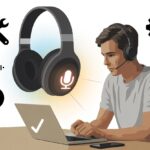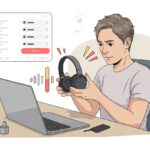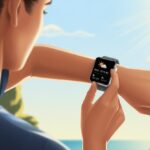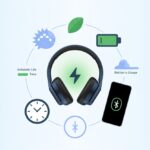Let’s be real—few things are as irritating as getting ready for music or a podcast, only to discover our Bluetooth headphones just won’t charge. We’ve all twisted the cord, stared into the charging port, and maybe muttered a few choice words. Sometimes, though, our trusty headphones just won’t play along.
Here’s the upside: most Bluetooth headphone charging issues have simple fixes if we’re willing to try a few things.
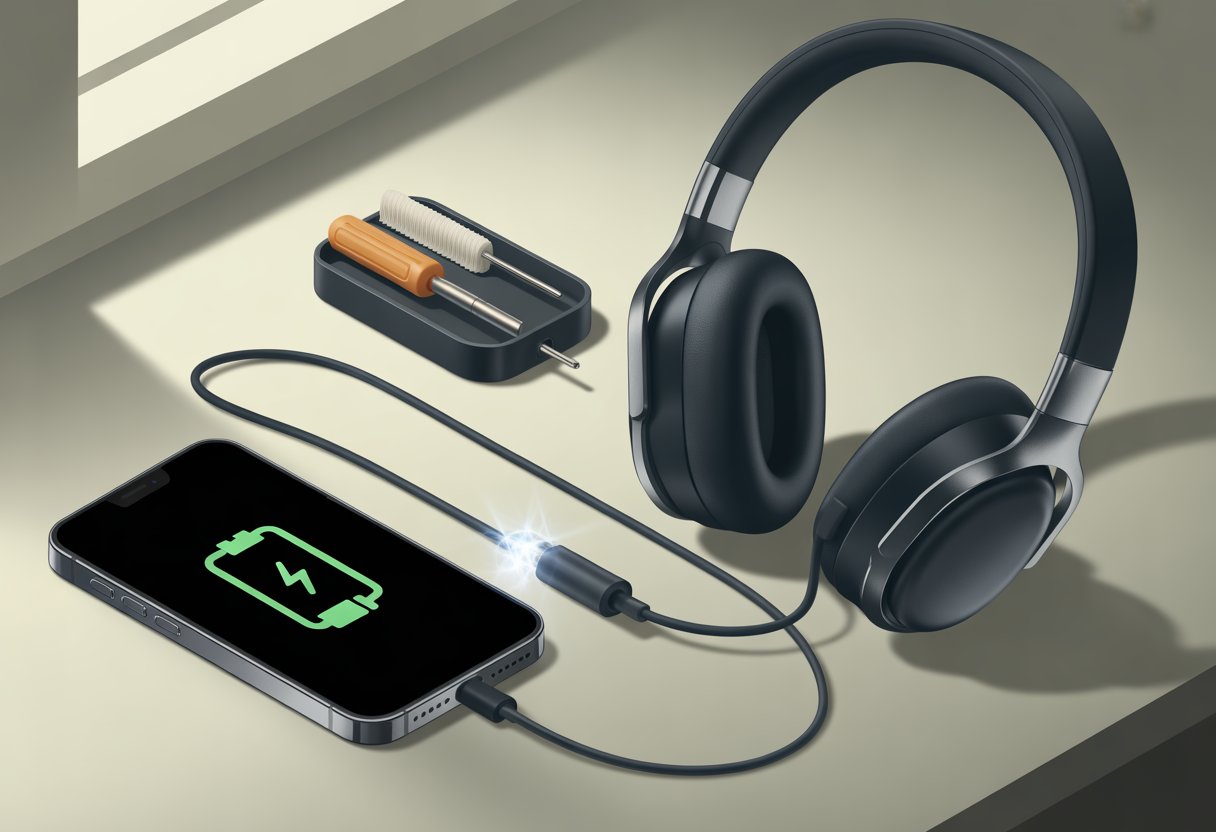
We don’t need to be tech wizards to sort this out. Checking contact points, clearing out gunk, or doing a hard reset—these are all things we can handle at home.
Before tossing our headphones or hitting “buy now” on a new pair, let’s see if we can solve the problem ourselves and get back to our playlists.
So, instead of mourning our quiet headphones, let’s dig in and see what actually helps. Maybe we’ll laugh a little too.
Diagnosing Bluetooth Headphone Charging Problems
Nothing kills a jam session faster than headphones that won’t charge. Before we freak out or threaten to launch them into space, let’s run through a quick checklist.
Common Signs Your Battery Will Not Charge
Some battery issues really sneak up on us. Our headphones might not turn on, even after hours plugged in. We press the power button, but nothing happens.
Sometimes, the battery just won’t hold a charge at all. We might notice weird blinking lights or the charger getting ignored. Occasionally, we see the infamous “eight second red light” and then—darkness.
That usually means the battery is too drained to charge properly. If we’re always stuck next to the charger, our battery’s basically waving a white flag.
Other signs include:
- Battery drains way too fast
- The charger or power bank doesn’t even recognize the headphones
- The charging indicator barely flickers or stays off
Checking The Charging LED
That little charging LED can be a lifesaver—if we pay attention. Most headphones have a tiny light that tells us what’s up.
If the LED stays dark when we plug in, something’s wrong with the power. A steady red or orange light usually means charging is happening. Some brands switch to green when they’re done.
But if the LED blinks, shuts off fast, or never lights up, we might have a charging issue or a bad cable. Sometimes, a flashing light means a loose connection or a dying battery.
If the LED never lights up, maybe the cable isn’t plugged in properly—or maybe the battery’s just given up. Try wiggling the cable a bit; if the light flickers, there’s probably a loose port or a finicky wire.
Identifying Charging Port Issues
The charging port hides a lot of secrets. Lint, dust, and pocket fuzz love to settle in there, blocking the cable from making good contact.
Before blaming the battery, grab a flashlight and play headphone detective—check the port closely.
Watch out for these clues:
- The cable feels loose or doesn’t snap in right
- The port looks bent, dented, or mysteriously dirty
- Charging only works if you hold the cable at a weird angle
If cleaning with a soft brush or a shot of compressed air doesn’t fix it, we might have bent pins or deeper damage. Swapping in a different cable or adapter can help rule out accessory problems.
If the port itself is the culprit, maybe it’s time for a repair shop—or at least a dramatic sigh. Checking the port first can save us from buying new headphones when a dust bunny is the real troublemaker.
Inspecting Charging Cables And Accessories
Before blaming the headphones for being lazy, let’s make sure the cable, charging case, or charger isn’t the real problem. Sometimes it’s the little things—a sketchy USB cable or a tired charger plug—that keep our battery life “on the edge.”
Testing The USB Cable
Let’s face it, USB cables multiply in our drawers. Not all of them work equally well. Some are solid, others are barely hanging on.
A cable might look fine, but a broken wire inside can stop it from working. Grab a USB cable that’s worked recently with another device and try it on the headphones.
If the headphones start charging, great! If not, the cable’s probably bad. We can also plug the cable into another device, like a phone, to see if it charges anything at all.
If it doesn’t, time to retire that cable.
-
Table: Signs Your Charging Cable Is Retired
Symptom What It Means Cable feels loose Connectors are worn out Frayed or bent ends Internal wire is damaged No charging at all Time for a new cable
Evaluating Your Charging Case
Let’s not forget the charging case, especially for wireless earbuds. The case has metal contacts that need to touch the earbud’s contacts.
If we see dirt, dust, or lint, it could mess things up. Clean the contacts gently with a dry toothbrush or a soft cotton swab.
If only one earbud charges, swap them. If the “dead” earbud comes back to life, maybe only one side of the case has a problem.
More tips about charging contacts are in this guide.
Pro tip: Some cases have their own batteries. If the case is dead, nothing gets charged. Plug in the case and watch for any indicator lights.
Trying A Different USB Charger
We all have that one ancient USB charger that tries its best but just can’t keep up. Chargers come in all shapes and sizes, and older ones might not deliver enough power.
If we use a weak or broken charger, the headphones might never charge. Try a different charger—preferably one that’s worked well with your phone or tablet.
Plug into a wall outlet instead of a computer, since computers sometimes don’t give enough power. Check the charger for any damage, strange smells, or loose prongs.
If the headphones charge with a new charger, bingo—we found the problem. The old one can go to the “tech graveyard” drawer.
For more troubleshooting tips, check out these extra tips.
Power Sources That Actually Work
Headphones that refuse to charge can really ruin your mood. The right power source makes all the difference.
The wrong one? That’s like watering a plant with soda—it just doesn’t work.
Matching Power Requirement With Your Device
We want our Bluetooth headphones to charge, but not every charger fits the job. Headphones usually need a specific voltage, often 5 volts.
Using a charger with the wrong voltage can leave us with silence. Check the specs near the charging port or in the manual.
If the headphones want 5V, give them 5V. Don’t grab a 12V laptop charger unless you’re looking for sparks (not recommended).
The charging cable should also match the device’s power requirement. If it doesn’t, we just get blinking lights and frustration.
Using The Correct Amp Rating
Borrowing our phone charger is tempting, but amps matter too. Headphones usually need less than 1 amp.
Phone chargers might deliver more, which can be risky for headphones. Too few amps, and we’ll be waiting forever for a full charge.
It’s like filling a pool with a teacup—slow and painful. Use a charger that matches the amp rating in the headphone specs.
If unsure, “output: 5V, 1A” is usually safe for most Bluetooth headphones.
Finding A Safety-Agency-Approved Power Supply
Nobody wants to see their headphones—or their table—go up in smoke. Look for chargers with safety marks from agencies like UL, CE, or ETL.
A safety-agency-approved charger means it’s tested and less likely to start a fire or fry your stuff.
Cheap knockoff chargers might save money, but they make every charge a gamble. Stick to trusted brands and check for those little logos.
Quick Tip: If a charger feels flimsy, smells weird, or has spelling mistakes on the label, skip it. Go for something safer.
Brand-Specific Troubleshooting: jbl, xtreme, And The Gang
Let’s admit it: our jbl and xtreme headphones aren’t perfect, and sometimes they push us to the brink. With a bit of patience, the right tools, and maybe a new USB cable, we can usually get things working again.
Solving JBL Charging Mysteries
When our JBL headphones refuse to charge, the reason is usually pretty simple. The charging cable causes problems more often than you’d think.
Faulty or just plain weird cables trip us up all the time. Just swap out the cable and see if the “charging” light pops on. It’s a quick fix that often works, and the official JBL support guide for charging problems backs this up.
Cleaning is another trick worth trying. Dust, lint, and even snack crumbs love to sneak into charging ports and connectors.
Grab a soft cloth or maybe a cotton swab if you’re feeling bold, and gently clean the contacts on both the headphones and the case. Regular cleaning can save you from weird charging hiccups, as JBL mentions on their support page about reconnecting charging.
Tips For Xtreme Model Owners
Let’s talk about the xtreme models—these things are built to last, but sometimes they just won’t charge. If you’ve checked the cable and adapter, maybe the charging port itself is loose or damaged.
That sounds dramatic, but ifixit’s xtreme troubleshooting guide says you can sometimes swap out the part if you’re brave enough to open the case.
Here’s a move for the bold: If your xtreme still ignores your charging attempts, try unplugging the battery and plugging it back in. Some Reddit users have had success by removing a few screws and disconnecting and reconnecting the battery—classic unplug-and-replug, but with more adventure (and tiny screwdrivers). You can find more details in this step-by-step Reddit post.
If nothing works, maybe your xtreme just wants to be an expensive paperweight for a while. At least it’s a good conversation starter.
What To Do When Resetting Is Your Only Hope
Sometimes, headphones decide they’re done working and leave us in silence. If cleaning, swapping cables, and even threatening to read the manual haven’t helped, it’s probably time to reset or call in the pros.
How To Reset Your Product
Resetting Bluetooth headphones is basically the tech version of “turn it off and on again.” Usually, you’ll find a reset button, which sometimes hides as the volume down or power button.
Most models want you to hold a button for 10-20 seconds. Others get fancy and want you to press multiple buttons at once, like you’re unlocking a secret level.
Here’s a classic reset routine:
- Turn off the headphones.
- Hold the reset or power button for about 10-20 seconds.
- Watch for blinking lights or a chime.
- Release and look for an indicator that things are better.
Resetting can clear up odd glitches or charging problems. Just remember, this wipes all your connections, so you’ll need to reconnect your devices. If you don’t know how to reset, check the manual or the official website (assuming you haven’t lost the manual ages ago).
When To Service Your Product
If you’ve reset, cleaned, and begged your headphones to cooperate and still get nothing, the battery or charging port might actually be toast. At this point, it’s time to let the professionals in.
Look for a nearby service center, or contact the manufacturer’s support for warranty or repair options. Sometimes, you’ll need a battery replacement—a job best left to the pros unless you’re feeling extra reckless.
If only one side won’t charge, dirt or a worn-out connector could be the culprit, and a technician can check that right away. You can always try community tips, like using rubbing alcohol to clean connectors, but for anything trickier, service is your safest bet.
Avoiding User Experience Nightmares
Nobody wants headphones that act up more than a soap opera star. Keeping Bluetooth headphones charged and ready means you get to enjoy music and podcasts without those sudden, awkward interruptions.
Good habits now mean less stress—and fewer embarrassing dance breaks—later.
Preventing Future Charging Headaches
Headphones have one job: stay charged for our next jam session. Let’s treat them right and use the charging cable that came with them whenever we can.
Not all chargers are created equal, and using random ones can make our headphones cranky.
We should clean the charging contacts regularly. A soft toothbrush or cotton swab works wonders on dust and pocket lint.
If the contacts look rusty or dirty, a gentle rub can really help.
When we store our headphones, let’s keep them in their case or on a stand. Tossing them into a bag with spare change and candy wrappers? That’s just asking for mysterious charging failures.
It’s safer for both our experience and their delicate wires.
Let’s also keep an eye out for firmware updates from the manufacturer. Sometimes, a new update will fix weird issues or help the battery last longer.
If nothing else works, we can always check out detailed guides on fixing Bluetooth headphone charging problems, so we don’t get left in silence.
Pro Tips For Keeping Rechargeable Batteries Happy
We all want our Bluetooth headphones to outlast our favorite TV shows. Taking care of the rechargeable batteries keeps them healthy and saves us from those annoying “battery low” warnings.
Proper Battery Care And Maintenance
Let’s be honest: rechargeable batteries are a little high-maintenance. They like routine.
Don’t let them drain all the way to zero before recharging. Try to keep their charge between 20% and 80% for a longer life.
Stick with the charger that came with your headphones. Grabbing a random cable from the mystery drawer can cause charging headaches.
Cleaning matters too. Dirty contact points can stop charging completely.
If things get grimy, a dry toothbrush or a little rubbing alcohol on a cotton swab helps a lot. You’ll find more cleaning tips in this Reddit guide on earbud charging fixes.
And don’t forget to store headphones in a cool, dry spot. Heat is the silent battery killer—so definitely don’t leave them sunbathing on the dashboard.
Plugging Into The Right USB Port
Let’s be real, our Bluetooth headphones need the right kind of love—which means plugging into the right USB port.
It’s wild how often we just grab any cable, stick it in any port, and expect magic. Not every USB port on our laptops or power bricks gives enough juice to charge headphones.
Some ports barely provide any power at all.
Here’s a quick checklist to avoid “dead headphone panic”:
- Try different USB ports. Some, especially on older computers, are only for data.
- Use a wall adapter. These usually give more power than laptop USB ports.
- Check your cable. If it’s frayed, chewed, or just looks sad, swap it out.
| USB Port Type | Charging Strength |
|---|---|
| USB 2.0 (computer) | Low (sometimes wimpy) |
| USB 3.0 (computer) | Good, but varies |
| Wall charger USB port | Best bet for fast juice |
If you see a connection error or the red charging light blinks off quickly, don’t just shrug it off. Some ports just aren’t up to the job.
When in doubt, rotate ports and cables like you do socks—often. Being picky about USB ports keeps your headphones alive and your playlists rolling.
Cookie Policy And Site Traffic: Random But Important
Ever wonder why a headphone article suddenly talks about cookies? It’s not because we swapped earbuds for chocolate chips.
Websites use cookies, and it actually matters for your reading (and shopping) habits.
Understanding Cookie Use
Let’s be real—wouldn’t it be great if cookies were actual snacks that showed up while we browsed? Sadly, website cookies aren’t edible.
When we visit a site, our browser grabs these small data files and tucks them away. They’re called cookies, but honestly, they’re more about convenience than dessert.
Websites use cookies to remember stuff for us. Maybe it’s keeping us logged into that headphone forum we love, or saving the color headphones we checked out a few days ago.
That way, we don’t have to keep clicking through the same menus over and over. It’s a small thing, but it saves time.
Cookies also help sites track site traffic. Owners get to see if just two people are reading their guide—or maybe two thousand.
A few tiny data crumbs might even record how long we spend reading about troubleshooting Bluetooth headphones. (No judgment if you bail out early.)
Most websites post a cookie policy that lays out what these files actually do. It’s kind of like reading the ingredients on a snack box—except this time, it’s about privacy, not calories.
If you’re curious about how your data gets used or want to turn off cookies, those policy pages usually explain exactly how to do it.
- Why do my Bluetooth headphones keep resetting? Solving the Mystery of Rebooting Ears - January 5, 2026
- Is WHOOP Worth It for Runners, Cyclists, and Weightlifters or Just Another Expensive Wrist Buddy? - January 5, 2026
- Best Fitness Trackers Under $200 That Won’t Make Your Wallet Sweat - January 4, 2026

